height BMW 745LI 2002 E66 Level Control System Manual
[x] Cancel search | Manufacturer: BMW, Model Year: 2002, Model line: 745LI, Model: BMW 745LI 2002 E66Pages: 57, PDF Size: 1.89 MB
Page 38 of 57
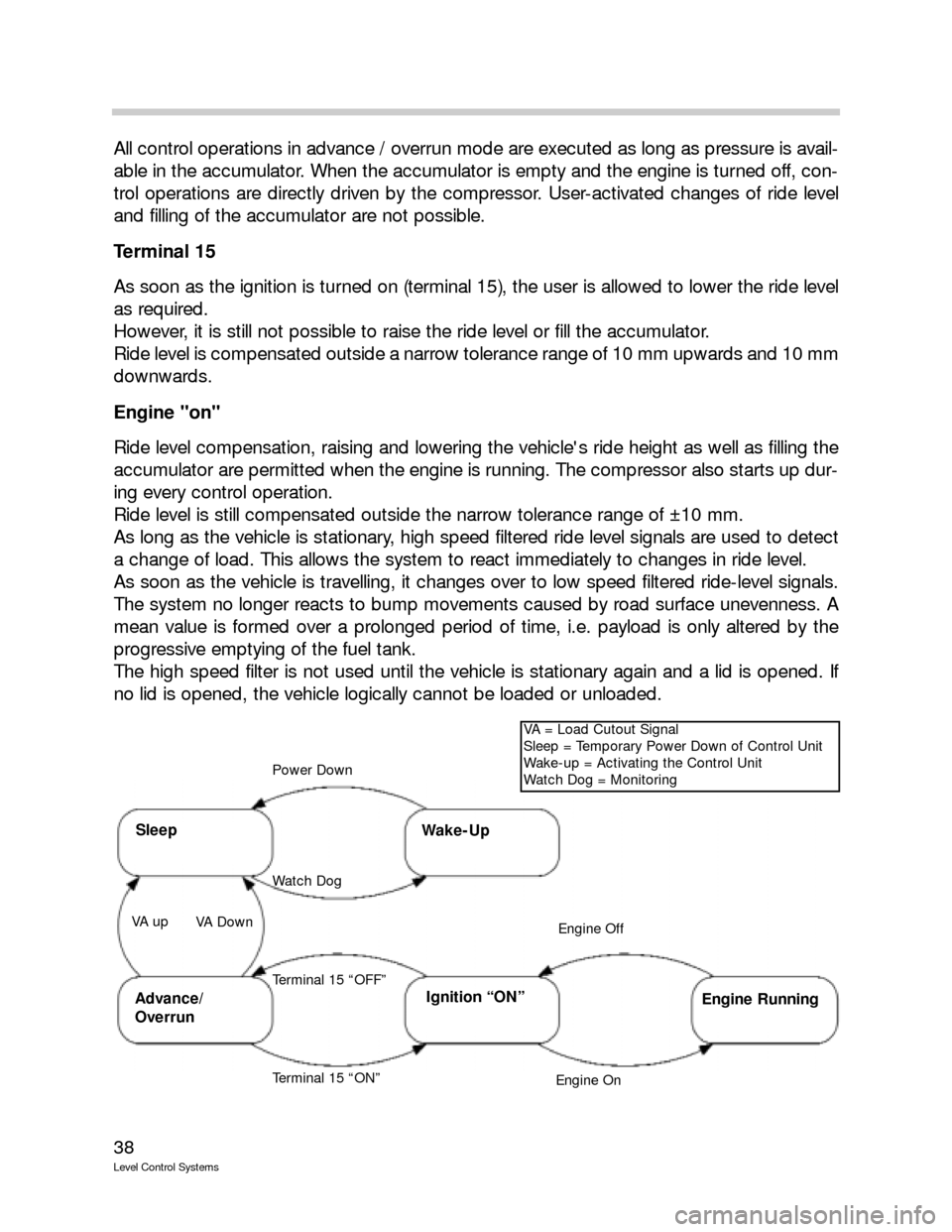
38
Level Control Systems
All control operations in advance / overrun mode are executed as long as pressure is avail-
able in the accumulator. When the accumulator is empty and the engine is turned off, con-
trol operations are directly driven by the compressor. User-activated changes of ride level
and filling of the accumulator are not possible.
Terminal 15
As soon as the ignition is turned on (terminal 15), the user is allowed to lower the ride level
as required.
However, it is still not possible to raise the ride level or fill the accumulator.
Ride level is compensated outside a narrow tolerance range of 10 mm upwards and 10 mm
downwards.
Engine "on"
Ride level compensation, raising and lowering the vehicle's ride height as well as filling the
accumulator are permitted when the engine is running. The compressor also starts up dur-
ing every control operation.
Ride level is still compensated outside the narrow tolerance range of ±10 mm.
As long as the vehicle is stationary, high speed filtered ride level signals are used to detect
a change of load. This allows the system to react immediately to changes in ride level.
As soon as the vehicle is travelling, it changes over to low speed filtered ride-level signals.
The system no longer reacts to bump movements caused by road surface unevenness. A
mean value is formed over a prolonged period of time, i.e. payload is only altered by the
progressive emptying of the fuel tank.
The high speed filter is not used until the vehicle is stationary again and a lid is opened. If
no lid is opened, the vehicle logically cannot be loaded or unloaded.
SleepWake-Up
Power Down
Watch Dog
Ignition “ON”Advance/
Overrun
VA = Load Cutout Signal
Sleep = Temporary Power Down of Control Unit
Wake-up = Activating the Control Unit
Watch Dog = Monitoring
Engine Off
Engine On
Engine Running
Terminal 15 “ON” VA up
VA Down
Terminal 15 “OFF”
Page 39 of 57
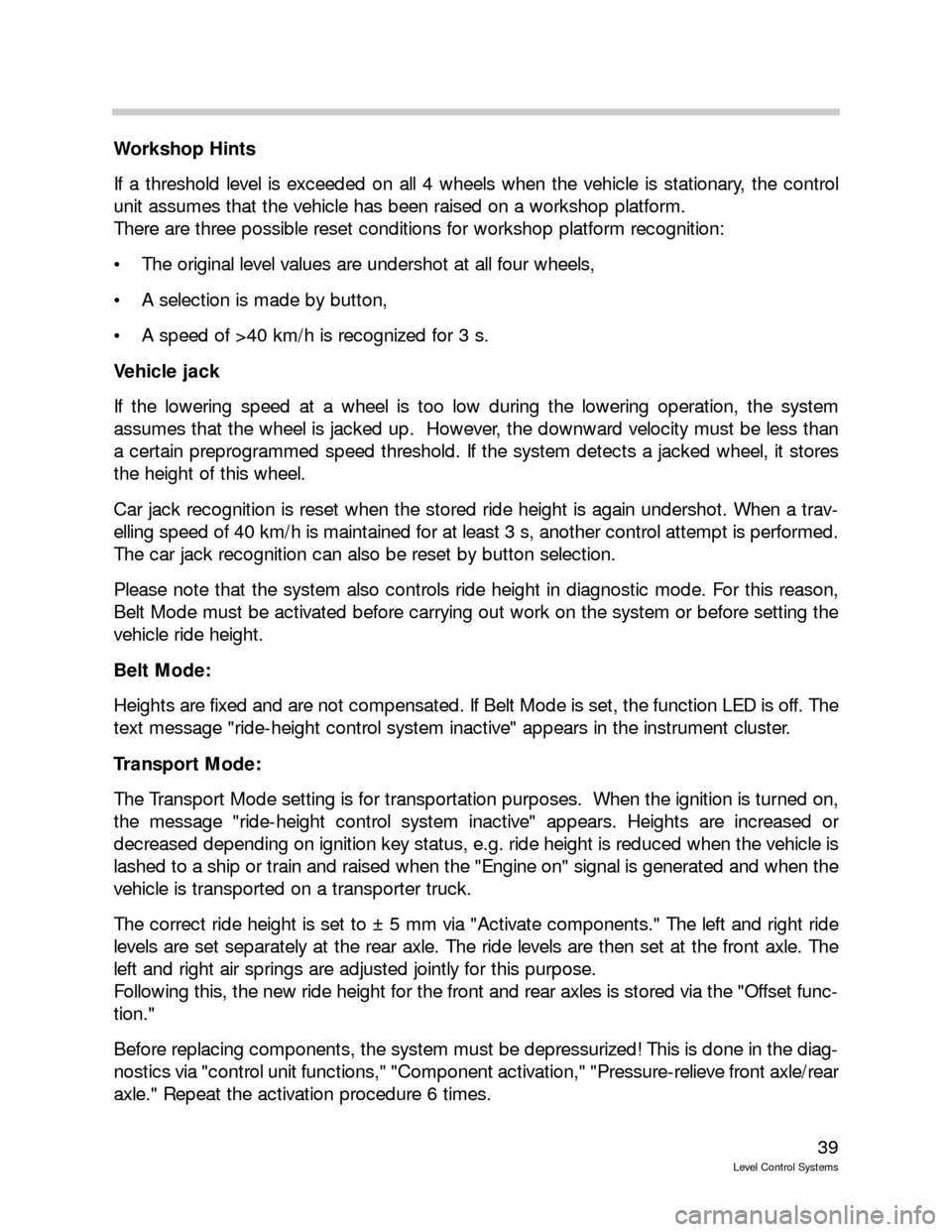
39
Level Control Systems
Workshop Hints
If a threshold level is exceeded on all 4 wheels when the vehicle is stationary, the control
unit assumes that the vehicle has been raised on a workshop platform.
There are three possible reset conditions for workshop platform recognition:
The original level values are undershot at all four wheels,
A selection is made by button,
A speed of >40 km/h is recognized for 3 s.
Vehicle jack
If the lowering speed at a wheel is too low during the lowering operation, the system
assumes that the wheel is jacked up. However, the downward velocity must be less than
a certain preprogrammed speed threshold. If the system detects a jacked wheel, it stores
the height of this wheel.
Car jack recognition is reset when the stored ride height is again undershot. When a trav-
elling speed of 40 km/h is maintained for at least 3 s, another control attempt is performed.
The car jack recognition can also be reset by button selection.
Please note that the system also controls ride height in diagnostic mode. For this reason,
Belt Mode must be activated before carrying out work on the system or before setting the
vehicle ride height.
Belt Mode:
Heights are fixed and are not compensated. If Belt Mode is set, the function LED is off. The
text message "ride-height control system inactive" appears in the instrument cluster.
Transport Mode:
The Transport Mode setting is for transportation purposes. When the ignition is turned on,
the message "ride-height control system inactive" appears. Heights are increased or
decreased depending on ignition key status, e.g. ride height is reduced when the vehicle is
lashed to a ship or train and raised when the "Engine on" signal is generated and when the
vehicle is transported on a transporter truck.
The correct ride height is set to ± 5 mm via "Activate components." The left and right ride
levels are set separately at the rear axle. The ride levels are then set at the front axle. The
left and right air springs are adjusted jointly for this purpose.
Following this, the new ride height for the front and rear axles is stored via the "Offset func-
tion."
Before replacing components, the system must be depressurized! This is done in the diag-
nostics via "control unit functions," "Component activation," "Pressure-relieve front axle/rear
axle." Repeat the activation procedure 6 times.
Page 41 of 57
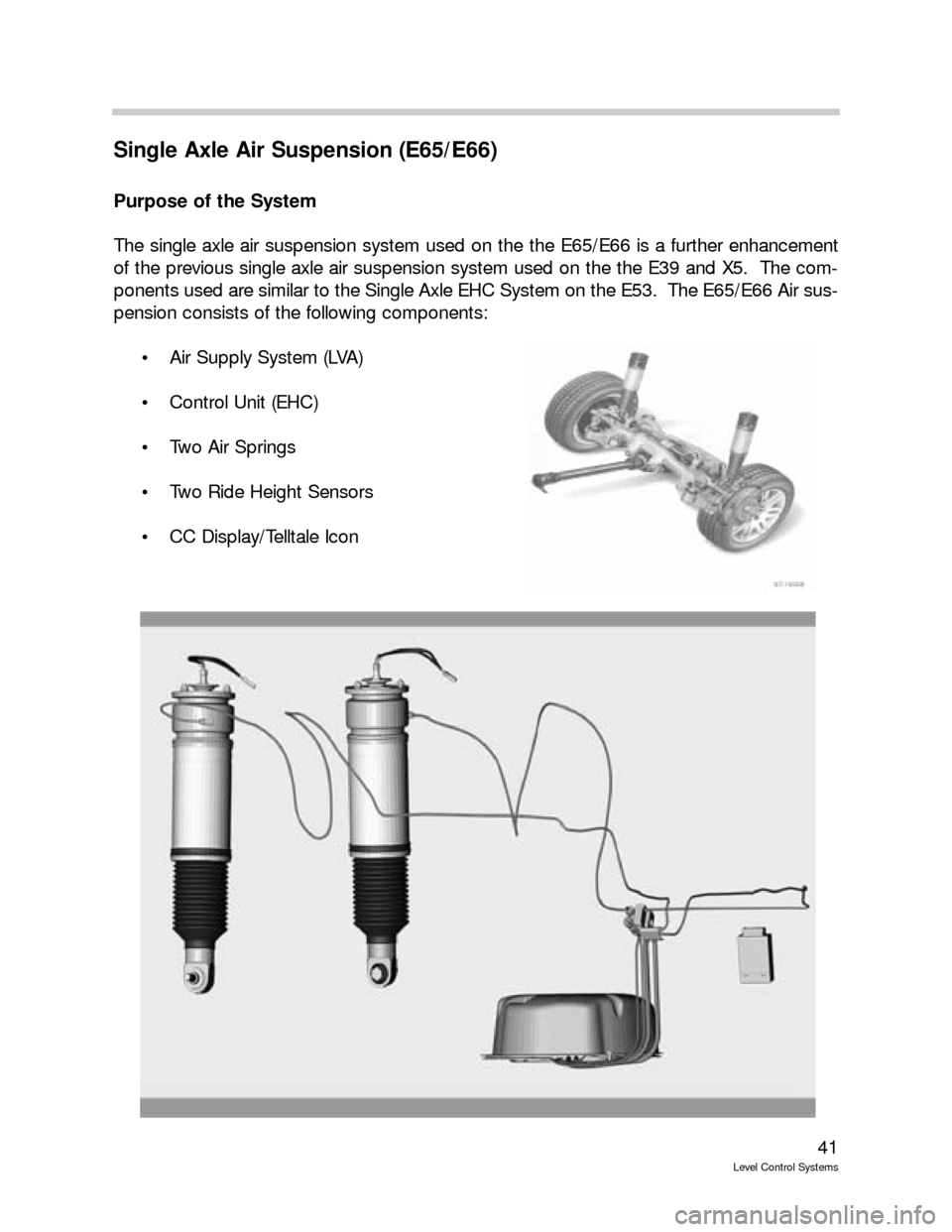
41
Level Control Systems
Single Axle Air Suspension (E65/E66)
Purpose of the System
The single axle air suspension system used on the the E65/E66 is a further enhancement
of the previous single axle air suspension system used on the the E39 and X5. The com-
ponents used are similar to the Single Axle EHC System on the E53. The E65/E66 Air sus-
pension consists of the following components:
Air Supply System (LVA)
Control Unit (EHC)
Two Air Springs
Two Ride Height Sensors
CC Display/Telltale Icon
Page 44 of 57
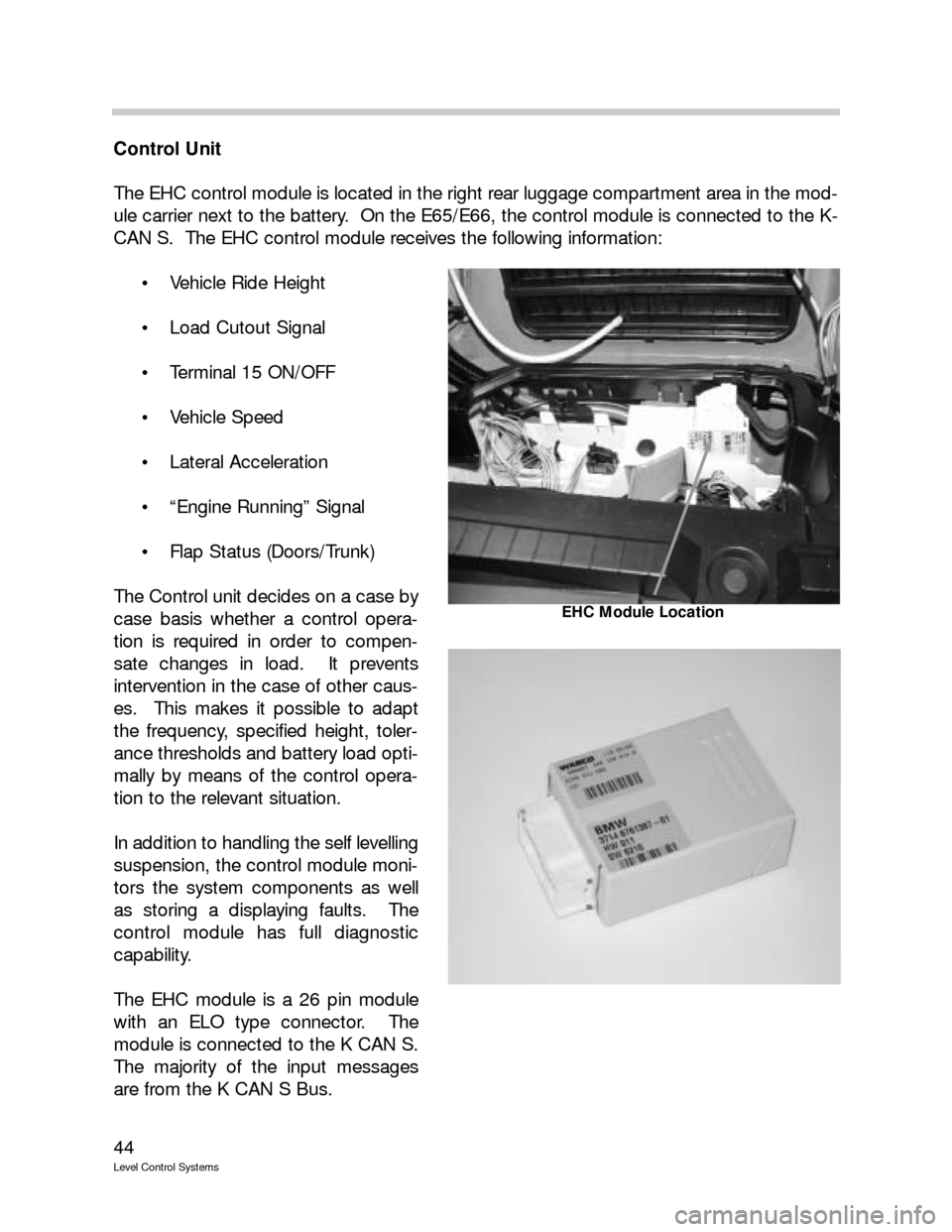
44
Level Control Systems
Control Unit
The EHC control module is located in the right rear luggage compartment area in the mod-
ule carrier next to the battery. On the E65/E66, the control module is connected to the K-
CAN S. The EHC control module receives the following information:
Vehicle Ride Height
Load Cutout Signal
Terminal 15 ON/OFF
Vehicle Speed
Lateral Acceleration
“Engine Running” Signal
Flap Status (Doors/Trunk)
The Control unit decides on a case by
case basis whether a control opera-
tion is required in order to compen-
sate changes in load. It prevents
intervention in the case of other caus-
es. This makes it possible to adapt
the frequency, specified height, toler-
ance thresholds and battery load opti-
mally by means of the control opera-
tion to the relevant situation.
In addition to handling the self levelling
suspension, the control module moni-
tors the system components as well
as storing a displaying faults. The
control module has full diagnostic
capability.
The EHC module is a 26 pin module
with an ELO type connector. The
module is connected to the K CAN S.
The majority of the input messages
are from the K CAN S Bus.
EHC Module Location
Page 46 of 57
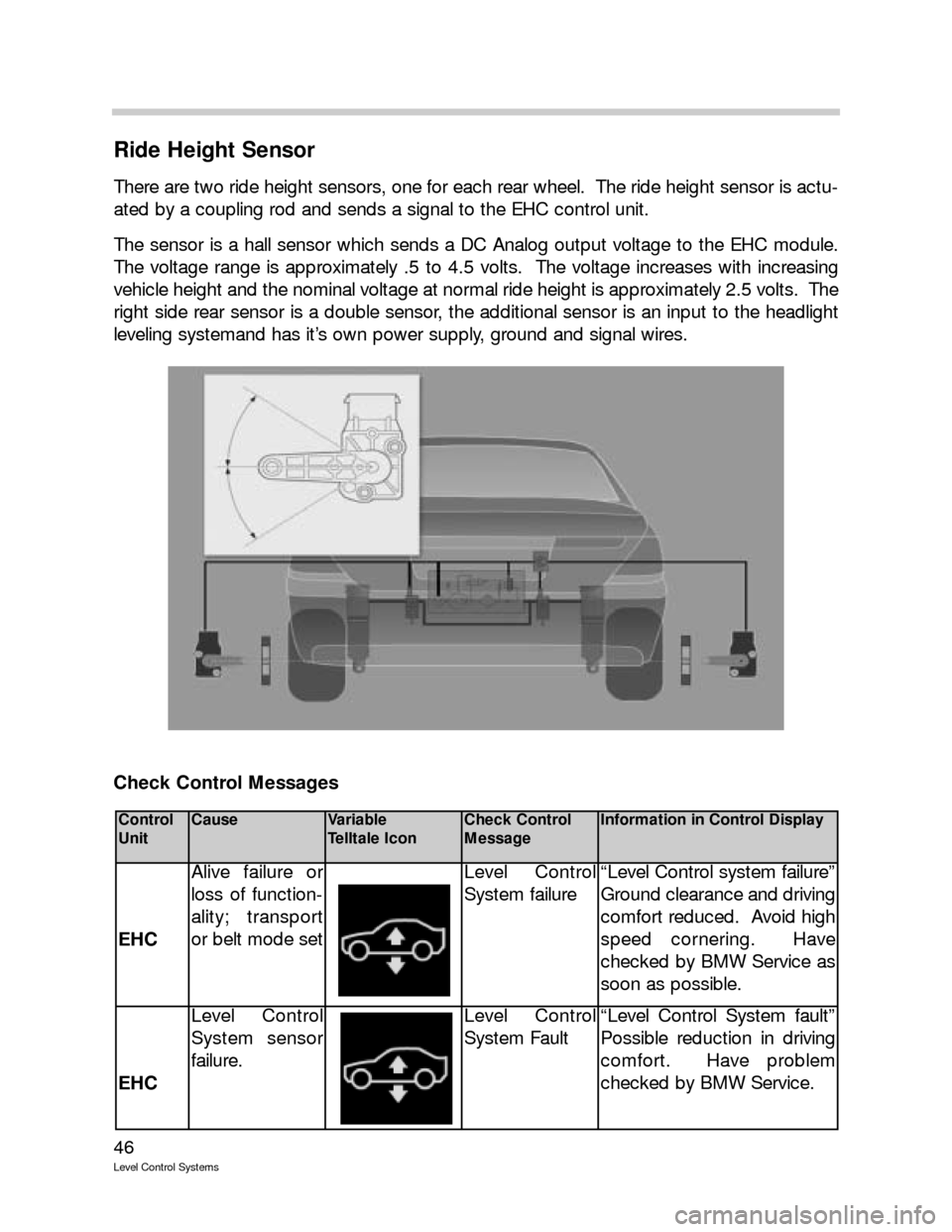
46
Level Control Systems
Ride Height Sensor
There are two ride height sensors, one for each rear wheel. The ride height sensor is actu-
ated by a coupling rod and sends a signal to the EHC control unit.
The sensor is a hall sensor which sends a DC Analog output voltage to the EHC module.
The voltage range is approximately .5 to 4.5 volts. The voltage increases with increasing
vehicle height and the nominal voltage at normal ride height is approximately 2.5 volts. The
right side rear sensor is a double sensor, the additional sensor is an input to the headlight
leveling systemand has it’s own power supply, ground and signal wires.
Check Control Messages
Control
UnitCauseVariable
Telltale IconCheck Control
MessageInformation in Control Display
EHC
Alive failure or
loss of function-
ality; transport
or belt mode setLevel Control
System failure“Level Control system failure”
Ground clearance and driving
comfort reduced. Avoid high
speed cornering. Have
checked by BMW Service as
soon as possible.
EHC
Level Control
System sensor
failure.Level Control
System Fault“Level Control System fault”
Possible reduction in driving
comfort. Have problem
checked by BMW Service.
Page 49 of 57
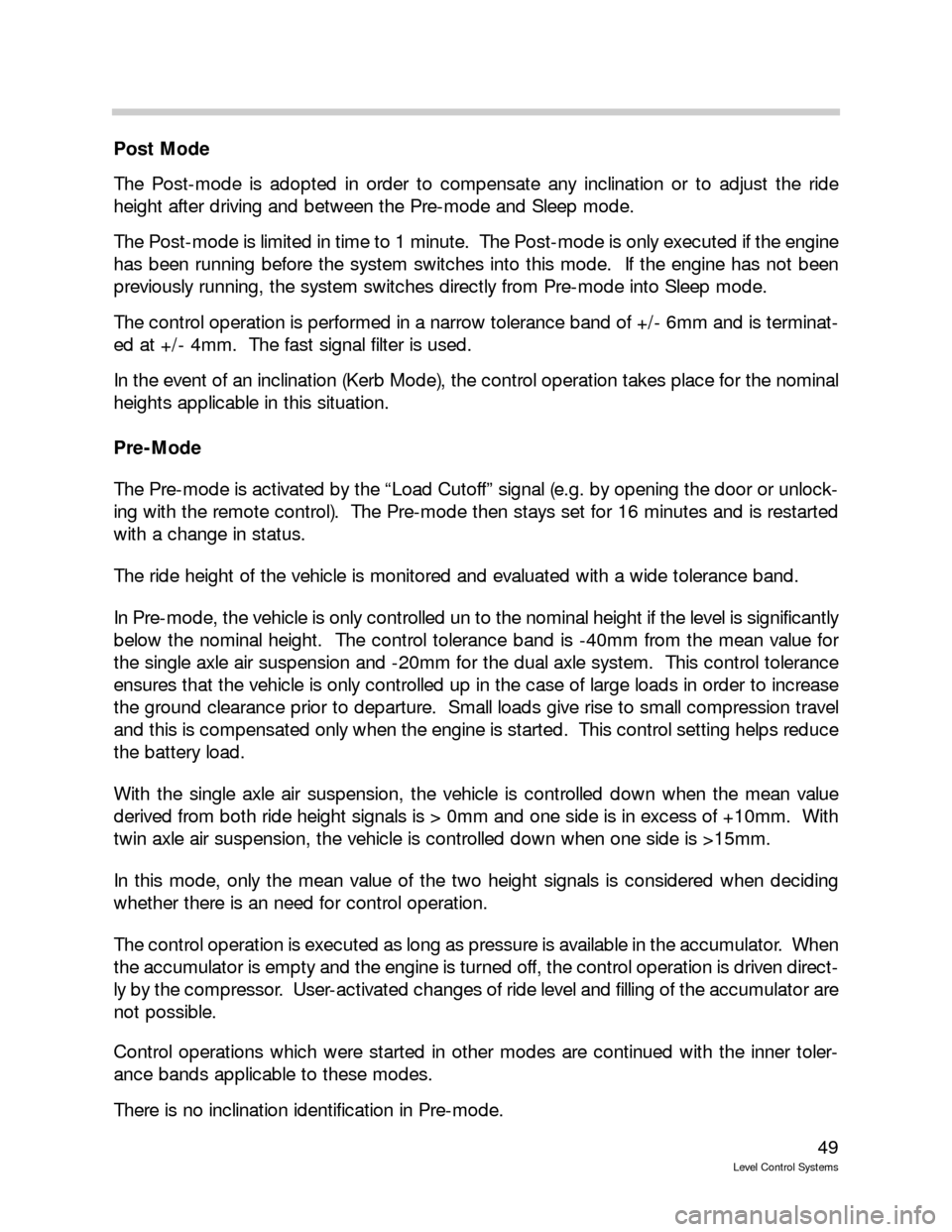
49
Level Control Systems
Post Mode
The Post-mode is adopted in order to compensate any inclination or to adjust the ride
height after driving and between the Pre-mode and Sleep mode.
The Post-mode is limited in time to 1 minute. The Post-mode is only executed if the engine
has been running before the system switches into this mode. If the engine has not been
previously running, the system switches directly from Pre-mode into Sleep mode.
The control operation is performed in a narrow tolerance band of +/- 6mm and is terminat-
ed at +/- 4mm. The fast signal filter is used.
In the event of an inclination (Kerb Mode), the control operation takes place for the nominal
heights applicable in this situation.
Pre-Mode
The Pre-mode is activated by the “Load Cutoff” signal (e.g. by opening the door or unlock-
ing with the remote control). The Pre-mode then stays set for 16 minutes and is restarted
with a change in status.
The ride height of the vehicle is monitored and evaluated with a wide tolerance band.
In Pre-mode, the vehicle is only controlled un to the nominal height if the level is significantly
below the nominal height. The control tolerance band is -40mm from the mean value for
the single axle air suspension and -20mm for the dual axle system. This control tolerance
ensures that the vehicle is only controlled up in the case of large loads in order to increase
the ground clearance prior to departure. Small loads give rise to small compression travel
and this is compensated only when the engine is started. This control setting helps reduce
the battery load.
With the single axle air suspension, the vehicle is controlled down when the mean value
derived from both ride height signals is > 0mm and one side is in excess of +10mm. With
twin axle air suspension, the vehicle is controlled down when one side is >15mm.
In this mode, only the mean value of the two height signals is considered when deciding
whether there is an need for control operation.
The control operation is executed as long as pressure is available in the accumulator. When
the accumulator is empty and the engine is turned off, the control operation is driven direct-
ly by the compressor. User-activated changes of ride level and filling of the accumulator are
not possible.
Control operations which were started in other modes are continued with the inner toler-
ance bands applicable to these modes.
There is no inclination identification in Pre-mode.
Page 50 of 57
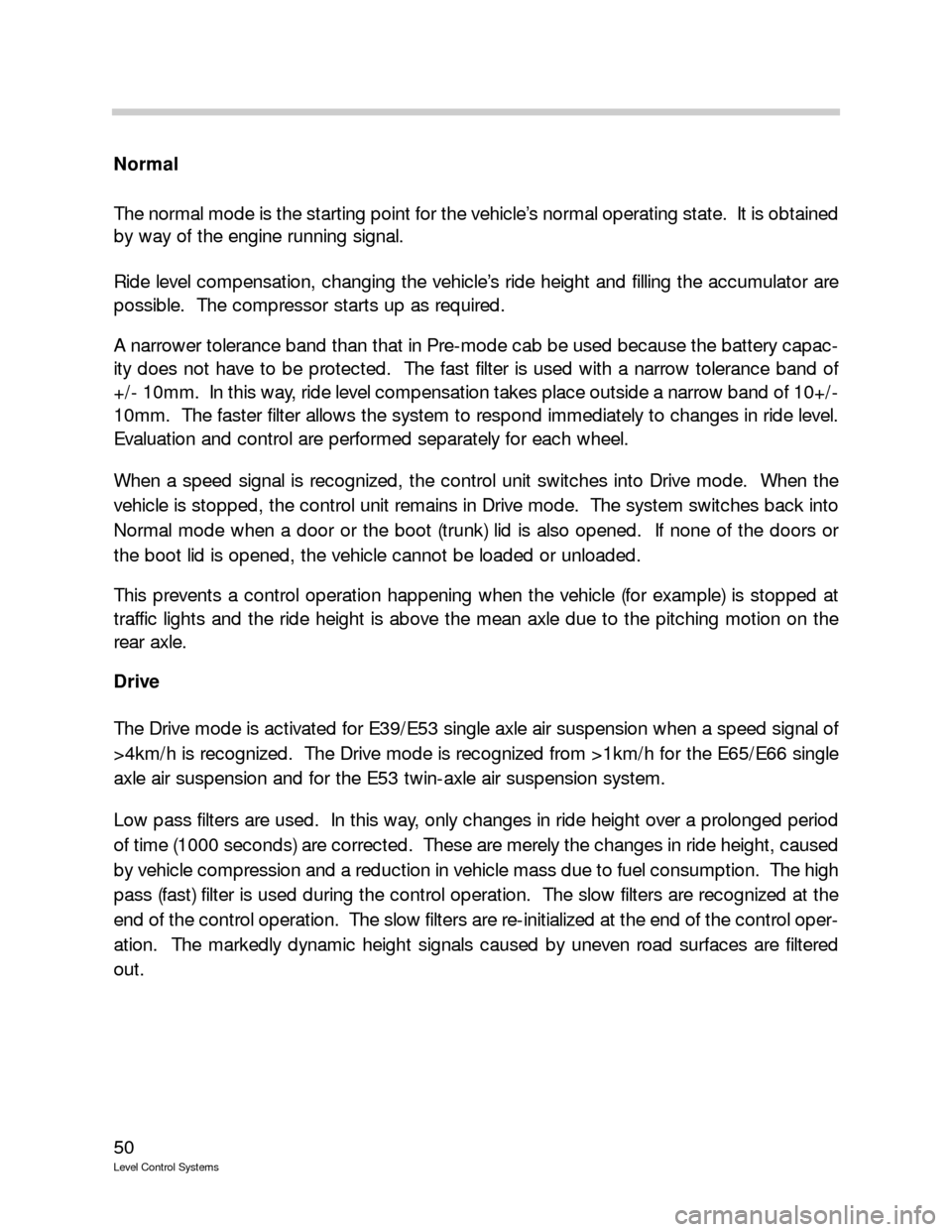
50
Level Control Systems
Normal
The normal mode is the starting point for the vehicle’s normal operating state. It is obtained
by way of the engine running signal.
Ride level compensation, changing the vehicle’s ride height and filling the accumulator are
possible. The compressor starts up as required.
A narrower tolerance band than that in Pre-mode cab be used because the battery capac-
ity does not have to be protected. The fast filter is used with a narrow tolerance band of
+/- 10mm. In this way, ride level compensation takes place outside a narrow band of 10+/-
10mm. The faster filter allows the system to respond immediately to changes in ride level.
Evaluation and control are performed separately for each wheel.
When a speed signal is recognized, the control unit switches into Drive mode. When the
vehicle is stopped, the control unit remains in Drive mode. The system switches back into
Normal mode when a door or the boot (trunk) lid is also opened. If none of the doors or
the boot lid is opened, the vehicle cannot be loaded or unloaded.
This prevents a control operation happening when the vehicle (for example) is stopped at
traffic lights and the ride height is above the mean axle due to the pitching motion on the
rear axle.
Drive
The Drive mode is activated for E39/E53 single axle air suspension when a speed signal of
>4km/h is recognized. The Drive mode is recognized from >1km/h for the E65/E66 single
axle air suspension and for the E53 twin-axle air suspension system.
Low pass filters are used. In this way, only changes in ride height over a prolonged period
of time (1000 seconds) are corrected. These are merely the changes in ride height, caused
by vehicle compression and a reduction in vehicle mass due to fuel consumption. The high
pass (fast) filter is used during the control operation. The slow filters are recognized at the
end of the control operation. The slow filters are re-initialized at the end of the control oper-
ation. The markedly dynamic height signals caused by uneven road surfaces are filtered
out.
Page 51 of 57
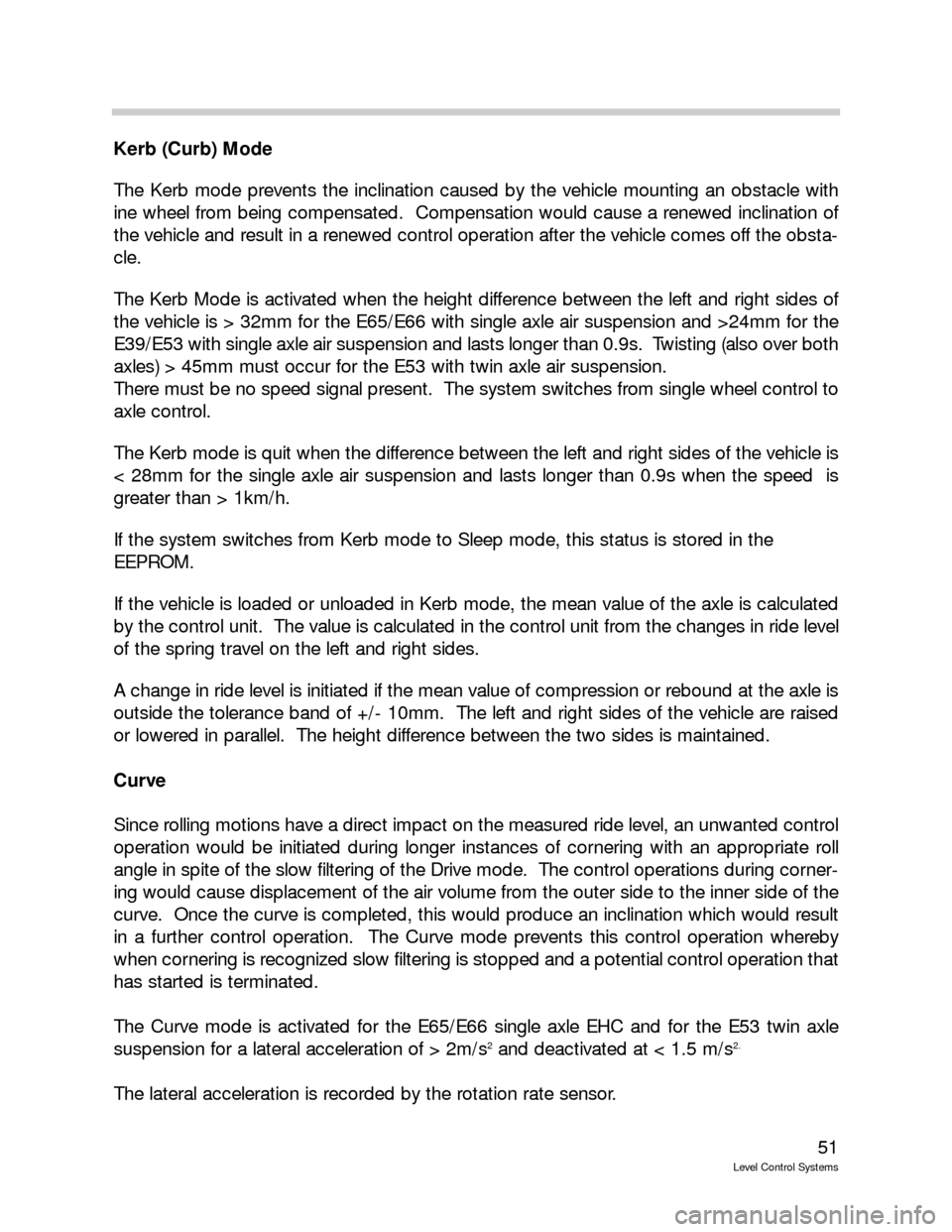
51
Level Control Systems
Kerb (Curb) Mode
The Kerb mode prevents the inclination caused by the vehicle mounting an obstacle with
ine wheel from being compensated. Compensation would cause a renewed inclination of
the vehicle and result in a renewed control operation after the vehicle comes off the obsta-
cle.
The Kerb Mode is activated when the height difference between the left and right sides of
the vehicle is > 32mm for the E65/E66 with single axle air suspension and >24mm for the
E39/E53 with single axle air suspension and lasts longer than 0.9s. Twisting (also over both
axles) > 45mm must occur for the E53 with twin axle air suspension.
There must be no speed signal present. The system switches from single wheel control to
axle control.
The Kerb mode is quit when the difference between the left and right sides of the vehicle is
< 28mm for the single axle air suspension and lasts longer than 0.9s when the speed is
greater than > 1km/h.
If the system switches from Kerb mode to Sleep mode, this status is stored in the
EEPROM.
If the vehicle is loaded or unloaded in Kerb mode, the mean value of the axle is calculated
by the control unit. The value is calculated in the control unit from the changes in ride level
of the spring travel on the left and right sides.
A change in ride level is initiated if the mean value of compression or rebound at the axle is
outside the tolerance band of +/- 10mm. The left and right sides of the vehicle are raised
or lowered in parallel. The height difference between the two sides is maintained.
Curve
Since rolling motions have a direct impact on the measured ride level, an unwanted control
operation would be initiated during longer instances of cornering with an appropriate roll
angle in spite of the slow filtering of the Drive mode. The control operations during corner-
ing would cause displacement of the air volume from the outer side to the inner side of the
curve. Once the curve is completed, this would produce an inclination which would result
in a further control operation. The Curve mode prevents this control operation whereby
when cornering is recognized slow filtering is stopped and a potential control operation that
has started is terminated.
The Curve mode is activated for the E65/E66 single axle EHC and for the E53 twin axle
suspension for a lateral acceleration of > 2m/s
2and deactivated at < 1.5 m/s2.
The lateral acceleration is recorded by the rotation rate sensor.
Page 52 of 57
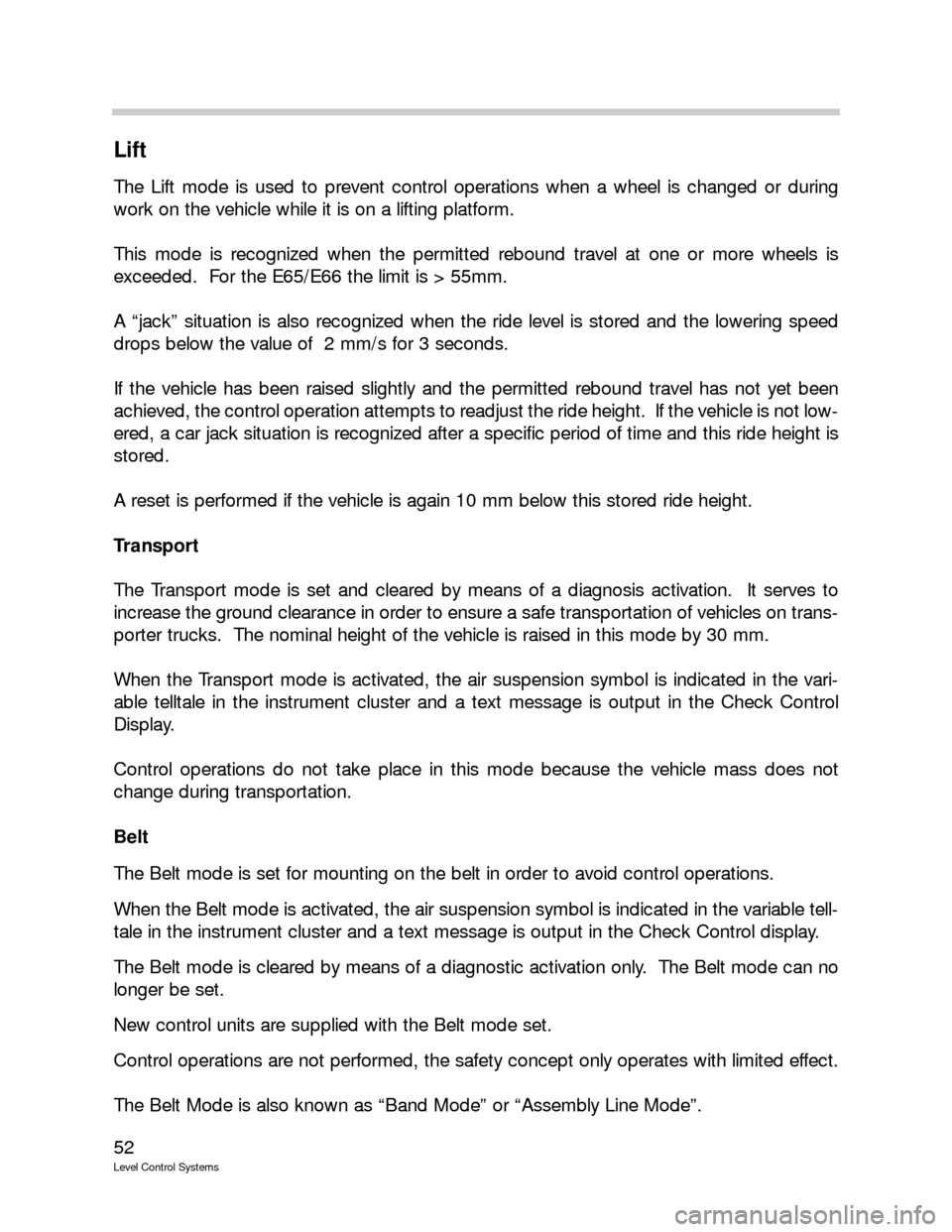
52
Level Control Systems
Lift
The Lift mode is used to prevent control operations when a wheel is changed or during
work on the vehicle while it is on a lifting platform.
This mode is recognized when the permitted rebound travel at one or more wheels is
exceeded. For the E65/E66 the limit is > 55mm.
A “jack” situation is also recognized when the ride level is stored and the lowering speed
drops below the value of 2 mm/s for 3 seconds.
If the vehicle has been raised slightly and the permitted rebound travel has not yet been
achieved, the control operation attempts to readjust the ride height. If the vehicle is not low-
ered, a car jack situation is recognized after a specific period of time and this ride height is
stored.
A reset is performed if the vehicle is again 10 mm below this stored ride height.
Transport
The Transport mode is set and cleared by means of a diagnosis activation. It serves to
increase the ground clearance in order to ensure a safe transportation of vehicles on trans-
porter trucks. The nominal height of the vehicle is raised in this mode by 30 mm.
When the Transport mode is activated, the air suspension symbol is indicated in the vari-
able telltale in the instrument cluster and a text message is output in the Check Control
Display.
Control operations do not take place in this mode because the vehicle mass does not
change during transportation.
Belt
The Belt mode is set for mounting on the belt in order to avoid control operations.
When the Belt mode is activated, the air suspension symbol is indicated in the variable tell-
tale in the instrument cluster and a text message is output in the Check Control display.
The Belt mode is cleared by means of a diagnostic activation only. The Belt mode can no
longer be set.
New control units are supplied with the Belt mode set.
Control operations are not performed, the safety concept only operates with limited effect.
The Belt Mode is also known as “Band Mode” or “Assembly Line Mode”.
Page 53 of 57
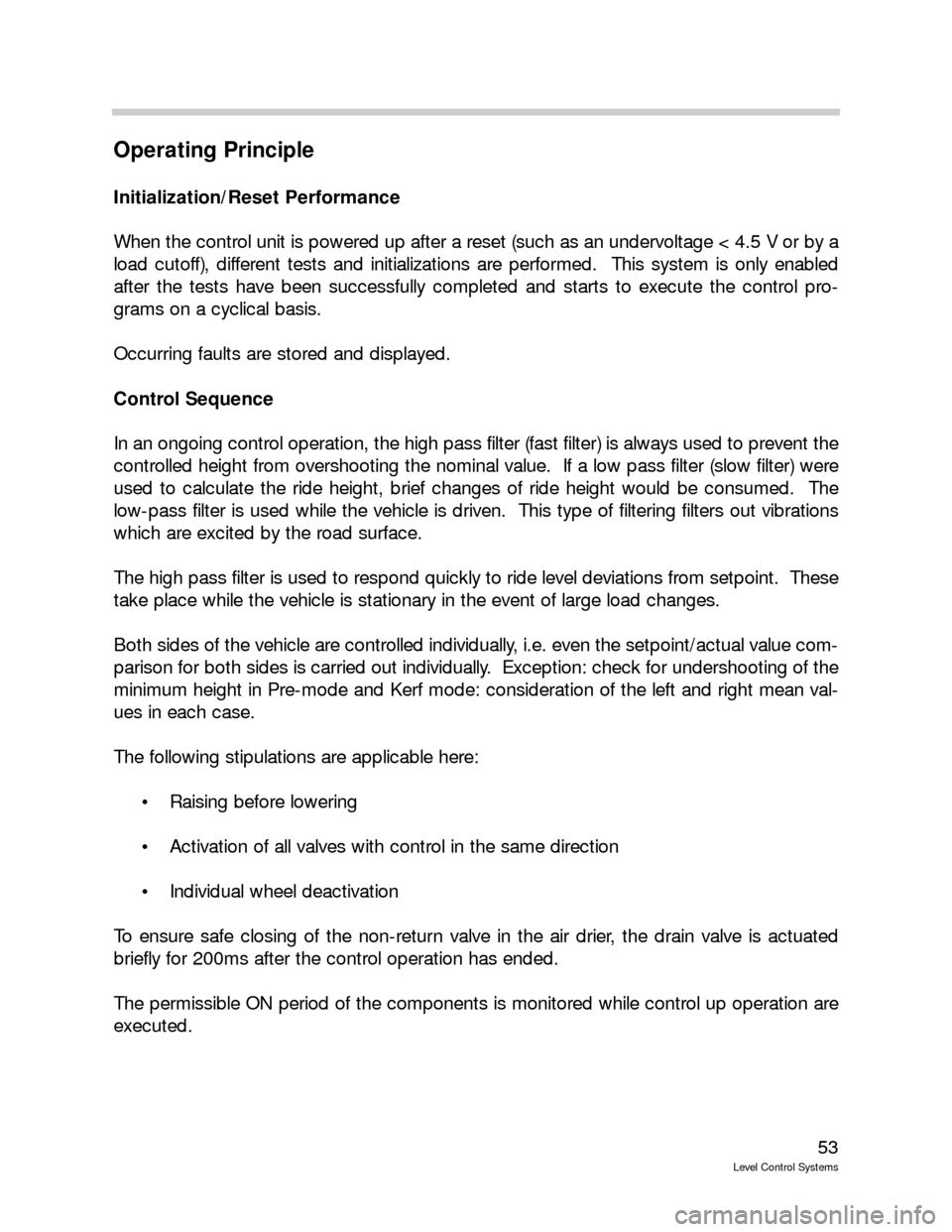
53
Level Control Systems
Operating Principle
Initialization/Reset Performance
When the control unit is powered up after a reset (such as an undervoltage < 4.5 V or by a
load cutoff), different tests and initializations are performed. This system is only enabled
after the tests have been successfully completed and starts to execute the control pro-
grams on a cyclical basis.
Occurring faults are stored and displayed.
Control Sequence
In an ongoing control operation, the high pass filter (fast filter) is always used to prevent the
controlled height from overshooting the nominal value. If a low pass filter (slow filter) were
used to calculate the ride height, brief changes of ride height would be consumed. The
low-pass filter is used while the vehicle is driven. This type of filtering filters out vibrations
which are excited by the road surface.
The high pass filter is used to respond quickly to ride level deviations from setpoint. These
take place while the vehicle is stationary in the event of large load changes.
Both sides of the vehicle are controlled individually, i.e. even the setpoint/actual value com-
parison for both sides is carried out individually. Exception: check for undershooting of the
minimum height in Pre-mode and Kerf mode: consideration of the left and right mean val-
ues in each case.
The following stipulations are applicable here:
Raising before lowering
Activation of all valves with control in the same direction
Individual wheel deactivation
To ensure safe closing of the non-return valve in the air drier, the drain valve is actuated
briefly for 200ms after the control operation has ended.
The permissible ON period of the components is monitored while control up operation are
executed.